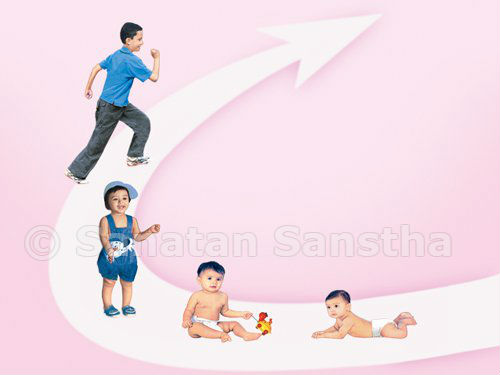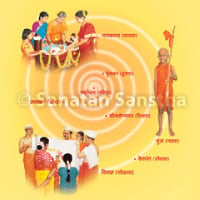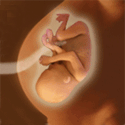Every parent naturally desires that his/her baby should be healthy, chubby and intelligent. To enjoy good fruits one has to plan and work hard. For planning, both the parents must have sound knowledge about the normal baby and infant care in general. The parents with sound knowledge only can manage the baby tactfully and with confidence. This article explains the various phases of baby development, essential nutrients for growth of the baby and importance of giving balanced and adequate diet to the baby rather than being dependent on tonics. The article also provides information on need for immunization and its Immunization schedule.
1. How much weight does a newborn baby put on in the first month ?
An average full term Indian baby weighs between 6.5 to 7.5 pounds at birth. The western babies weigh about one pound more at birth. Most of the newborn babies lose about 4 to 10 ounces i.e. 5 to 10% of their body weight in the first 3 to 4 days and regain their birth weight by about the 10th day. Premature babies continue to lose weight for the first 5 days and usually regain the birth weight within 12 to 18 days. The initial loss in weight is due to the passage of meconium i.e. stools collected for 9 months and poor intake by the baby. After regaining the birth weight, a normal baby puts on about one ounce of weight per day till the baby is 4 weeks old. At the end of one month, the baby puts on about 1 to 1.5 pounds.
2. What are the average growth and development parameters of a one year old child ?
Baby development and growth is fastest in the first year of life.
-
Weight : The full term baby doubles its birth weight by 5 months and trebles it by one year of
-
Length : The height e. the length of a normal newborn baby is about 48 cms. The baby increases in length by 20 to 25 cms during the first year of life.
-
Head circumference : The head circumference gives an idea about the size of the The head circumference is 33.5 cms at birth, 46 cms at one year and 53 cms in adults. By one year the brain attains 66 per cent of the size of the adult brain.
-
Development : A one year old baby can stand alone for a few seconds without support and can walk with one hand It obeys simple requests like “give me a spoon”. It reacts to vocal music and speaks 3 to 4 words. It can hold a pencil as if to mark on the paper.
It is important to remember that the constitution and therefore the growth parameters as well as the milestones vary considerably from child to child.
3. What are the manifestations of immaturity of various organs in young infants ?
Compared to adults all the organs in the babies are immature. This will be evident from the following facts :
- Heart : The resting heart rate in the newborn baby is double that of adults.
-
Lungs : The resting respiratory rate of the newborn baby is 40 per minute while that in adults is only 16 per minute.
-
Digestive organs : Absence of teeth and comparatively weak digestive power demands administration of liquid or well-cooked and well mashed food.
-
Kidneys : The capacity to concentrate urine is less in babies.
-
Skin : The skin of the babies is thin and Absence of sweating in the first few months makes them more susceptible to develop heat-fever during summer. Many toxic chemicals and drugs can get absorbed through its skin to produce toxicity in young babies unlike older children and adults.
- Brain :
- Immaturity of brain manifests in the following way :
Generalised reaction to any stimulus e.g. with a loud sound of a cracker an adult just blinks the eyes, whereas a young infant will get a startle reaction where the arms and legs come forward as if to embrace and cling to the mother and later the baby starts crying. Similarly, when an adult weeps, only the tears trickle from his eyes, whereas when the baby cries, the baby vigorously moves the entire body and all the limbs.
- Inadequate control of emotions like anger :
Many babies are not able to control their emotions like anger and continue to cry even if the root cause is removed e.g. if a hungry baby is not given milk immediately, it starts crying. Once the baby is upset it may refuse to suck even when it is offered the bottle of milk and may keep on crying till it gets exhausted. These crying episodes are common in infants below 3 months and may recur regularly daily in the evening. Hence they are sometimes called as evening colic.
- Convulsions :
Immaturity of the brain makes the infants more susceptible to develop convulsions with high fever.
Because of the immaturity of various organs, the baby is not able to withstand the stress situations like an adult.
4. What are the normal, daily requirements of essential nutrients for optimum growth of an infant ?
The average daily requirements of important nutrients of a newborn baby, one year old baby and an adult are given in the following table :
| Daily requirements | Newborn baby | One year old baby | Adult |
|---|---|---|---|
| Calories per kg. | 120 | 105 | 40 |
| Proteins in grams per kg | 2.5 | 2 | 0.75 |
| Vitamin A (i.u.) | 1400 | 2000 | 5000 |
| Vitamin D (i.u.) | 500 | 400 | 400 |
| Vitamin C (mg.) | 35 | 35 | 4 |
| Vitamin B1 mg.) | 0.3 | 0.5 | 1.5 |
| Vitamin B12 (mcg.) | 0.3 | 0.3 | 3.0 |
| Calcium (mg.) | 360 | 540 | 1200 |
| Iron (mg.) | 5 | 15 | 18 |
5. Should tonics be routinely given to growing children ?
Every mother likes to give the best tonic to her child. If one studies the tonics available in the market, one would realise that all the tonics are permutations and combinations of vitamins and minerals like vitamin A, B, C, D, Iron, and Calcium etc. Like diet, the deficiency as well as excess of tonics too, is harmful to the baby. If the child’s diet contains an inadequate amount of iron, the child will suffer from iron deficiency anemia and his hemoglobin in the blood will be low. If such a child is given tonic in the form of iron liquid or iron tablets, his anemia will disappear and blood hemoglobin will go up, appetite will improve and he will gain some weight. However, if the child who has 100% hemoglobin in the blood is given an iron tonic, it will not be absorbed and will not serve any useful purpose. If one persists in giving iron tonic to such a child, his appetite will on the contrary decrease. Same is true of excessive administration of vitamin A and D.
Rather than being after tonics, which can be harmful if taken in excess, it is important to see that the child takes an adequate and well balanced diet. An undernourished child should be given a high caloric and high protein diet rich in milk, pulses and nuts. On the other hand, an obese child should increase his intake of vegetables. A child with scurvy i.e. vitamin C deficiency should be given extra fresh fruits in his diet.
If one cannot afford fruits, milk and other costly items of food, there is nothing wrong in giving vitamins and minerals in the form of tonics if their deficiency exists or if daily food is not well balanced in terms of vitamins and minerals.
Bones and ribs of undernourished children are prominent because of the lack of the layer of fat below the skin. Such children are often wrongly considered as cases of rickets and given large doses of vitamin D and Calcium. These cases actually need more calories and protein through the medium of nourishing food.
6. What are the emergency signals in common diseases of infants ?
Air, water and food constitute the three essential substances necessary for sustenance of life. Without food, man can survive for a few weeks and without water for a few days but without air he cannot survive for more than a few minutes. Hence the common emergencies in most of the diseases are those of deficiency of air or water. These and other common emergency signals are mentioned below :
-
Breathlessness : Indicates deficiency of air. Younger the baby smaller the air These narrow air passages can be easily blocked by swelling of the inner lining of the air passages as in bronchopneumonia or spasm of air passages as is seen in asthma.
-
Vomiting : Persistent vomiting can quickly cause even if the child passes large quantities of liquid stools, the water loss can be made up by administering large quantities of fluids by mouth. However, if the child starts vomiting, there is no other way to replace the fluids except by administering intravenous glucose and saline.
-
Diarrhoea : Frequent passage of a large quantity of watery stools gives rise to water deficit.
-
A diminished quantity of urine : A marked diminution in the quantity of urine passed or not passing urine for more than 6 hours indicates water deficit.
-
High coloured urine : High coloured, brownish black or reddish urine indicates either presence of jaundice or inflammation of kidney.
-
High fever : High fever above 1020 F by itself can give rise to convulsions in some infants as their brain cannot tolerate it.
These symptoms indicate that the child may become serious and a child specialist should be consulted.
7. Recommended Immunization schedule for the children
Immunization of every child should begin when the baby is in mother’s womb, by giving Tetanus toxoid injection to the pregnant lady.
The recommended Immunization schedule in India is given below :
Revised IAP (Indian Association of Paediatrics) Immunization Schedule
| Age | Vaccine | Route | |
|---|---|---|---|
| Birth | BCG | – | I.D. |
| OPV | zero dose | Oral | |
| Hep.B | first dose | I.M. | |
| 6 weeks | DTwP / DTaP | first dose | I.M. |
| OPV (Note 1) / OPV + IPV | first dose | Oral(OPV) / I.M.(IPV) | |
| Hib | first dose | I.M. | |
| Hep.B | second dose | I.M. | |
| 10 weeks | DTwP / DTaP | second dose | I.M. |
| OPV / OPV + IPV | second dose | Oral(OPV) / I.M.(IPV) | |
| Hib | second dose | I.M. | |
| 14 weeks | DTwP / DTaP | third dose | I.M. |
| OPV / OPV + IPV | third dose | Oral(OPV) / I.M.(IPV) | |
| Hib | third dose | I.M. | |
| Hep.B (Note 2) | third dose | I.M. | |
| 9 months | Measles | – | S.C. |
| 15 – 18 months | DTwP / DTaP | booster dose 1 | I.M. |
| OPV / OPV + IPV | fourth dose | Oral(OPV) / I.M.(IPV) | |
| Hib | booster dose 1 | I.M. | |
| MMR | first dose | S.C. | |
| 2 years | Typhoid (Note 3) | first dose | I.M. |
| 5 years | DTwP / DTaP | booster dose 2 | I.M. |
| OPV | fifth dose | Oral | |
| MMR (Note 4) | second dose | S.C. | |
| 10 years | Tdap (Note 5) | – | I.M. |
| HPV (Note 6) | – | I.M. |
Note 1 – OPV alone if IPV cannot be given
Note 2 – The third dose of Hepatitis B can be given at 6 months
Note 3 – Revaccination every 3 years
Note 4 – The second dose of MMR vaccine can be given at any time 8 weeks after the first dose
Note 5 – The single dose of Tdap may be followed by Tetanus toxoid boosters every 10 years
Note 6 – Only females, three doses at 0, 1-2 and 6 months
[I.D. = Intra-dermal, I.M.= Intra-muscular, S.C. = Sub-cutaneous, Oral = By mouth]
Immunization schedule which is to be followed after one-to-one discussion with parents
(because of their high cost)
| Age | Vaccine | ||
|---|---|---|---|
| Less than 6 weeks |
|
||
| Less than 15 months | Varicella (Note 3) | ||
| Less than 18 months | Hepatitis A (Note 4) |
Note 1 – Rotavirus vaccine (2/3 doses (depending on brand) at 4-8 weeks interval)
Note 2 – PCV 7 (three doses at 6, 10, 14 weeks and 1 booster at 15-18 months)
Note 3 – Varicella (<13 years single dose, >13 years two doses at 4-8 weeks interval)
Note 4 – Hepatitis A (two doses at 6 months interval)
Notes :
BCG : For prevention of tuberculosis
OPV : Oral Polio Vaccine – drops given by mouth for prevention of polio
IPV : Inactivated Polio virus Vaccine given intramuscularly
Hep.B : Vaccine for prevention of jaundice caused by Hepatitis B virus
DTP : For prevention of Diphtheria, Tetanus and Pertussis that is whooping cough
DTwP : DTP vaccine in which Pertussis vaccine is with dead whooping cough germ cells. (w = whole)
DTaP : DTP vaccine in which Pertussis vaccine is without cells. Therefore, it is less toxic but more expensive. (a = acellular)
Hib : For prevention of influenza
MMR : For prevention of Measles, Mumps and Rubella that is German measles
Booster dose : Given to intensify and sustain the effects of the first dose of the vaccine
Tdap : DTP vaccine with standard quantity Tetanus toxoid (T) and reduced quantity diphtheria (d) and acellular pertussis (ap) vaccines
HPV : Human Papilloma Virus for prevention of cancer of uterine cervix in females
Rotavirus vaccine : For prevention of severe diarrhoea caused by Rotavirus
PCV 7 : Pneumococcal Conjugated Vaccine 7 for prevention of pneumonia
Varicella : For prevention of chicken pox
Hepatitis A : For prevention of jaundice caused by Hepatitis A vaccine
Some of the vaccines if not given in the 1st year, can be given later.
References :
- Part 1. Text Series on ‘Guidance on Parenting’ : Vol. 3, Your Baby (Birth to 1 year)
- ‘Growth and development of your baby” by Dr. V.B.
- ‘Your Child (1 to 12 years)’ by Dr. V.B. Athavale.


 Sanskar Meaning and Definition
Sanskar Meaning and Definition Despite many births as a Human Being, why do Sanskar have to be made again ?
Despite many births as a Human Being, why do Sanskar have to be made again ? 16 Sanskar – Importance and Objectives
16 Sanskar – Importance and Objectives What is the aim of performing Sanskaras ?
What is the aim of performing Sanskaras ? Garbh Sanskar (Pre-birth Sanskar)
Garbh Sanskar (Pre-birth Sanskar) Discipline children before the child’s birth
Discipline children before the child’s birth